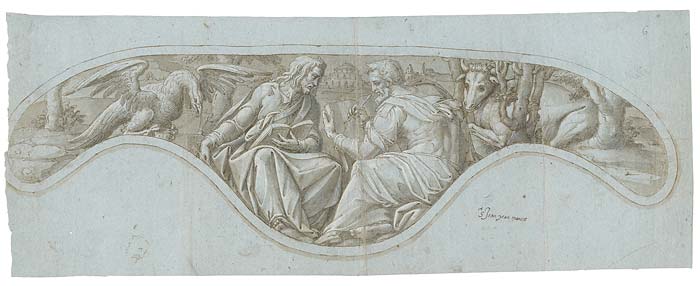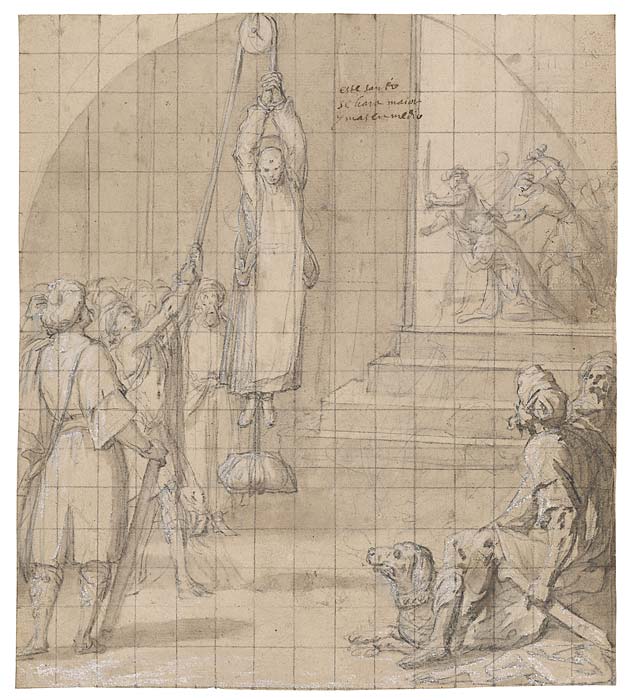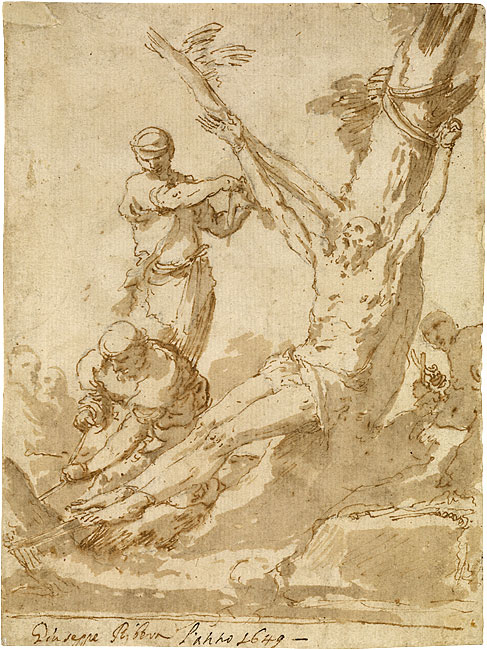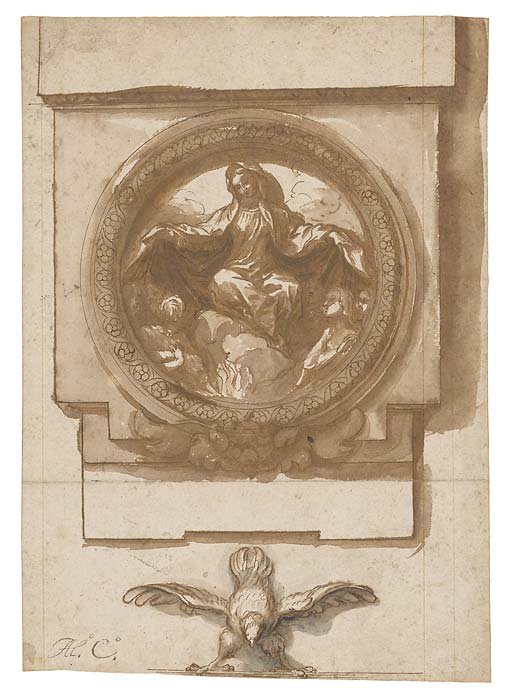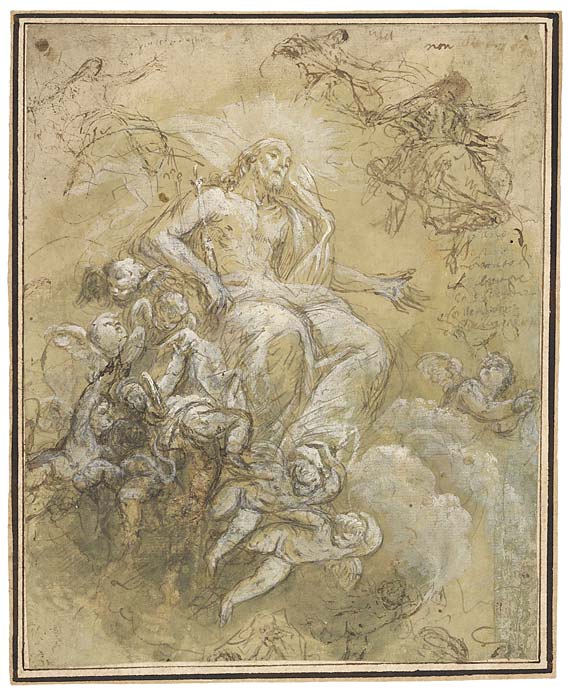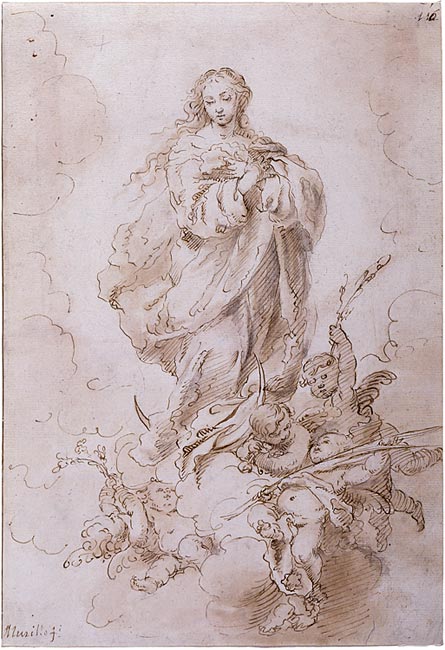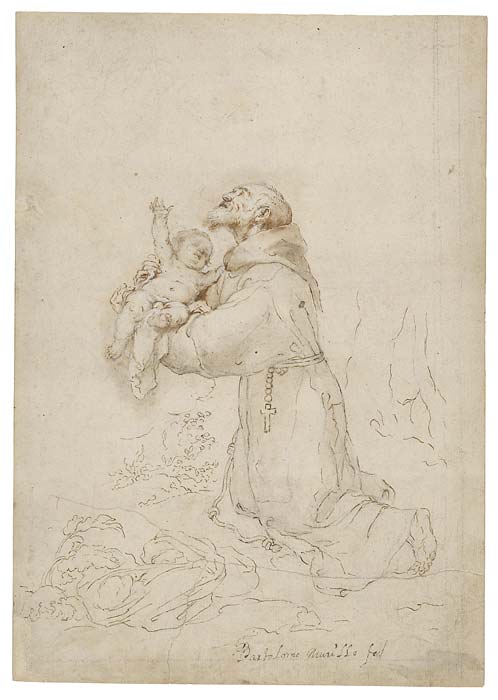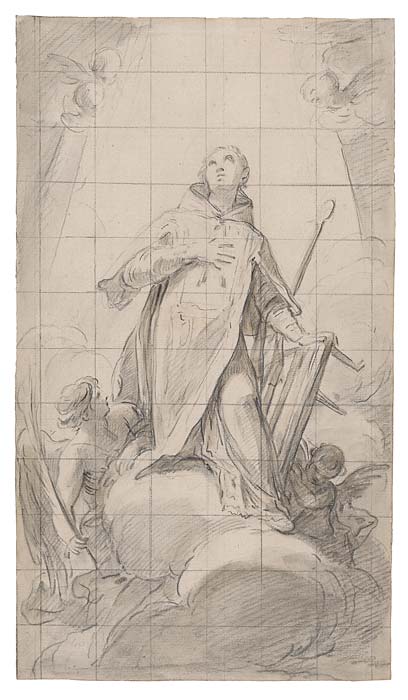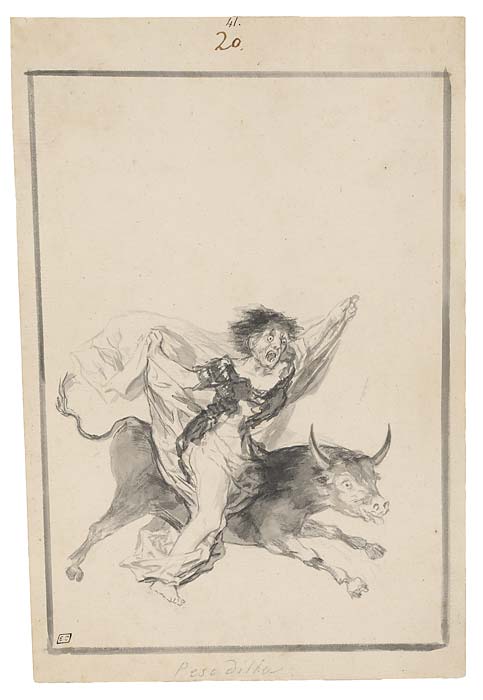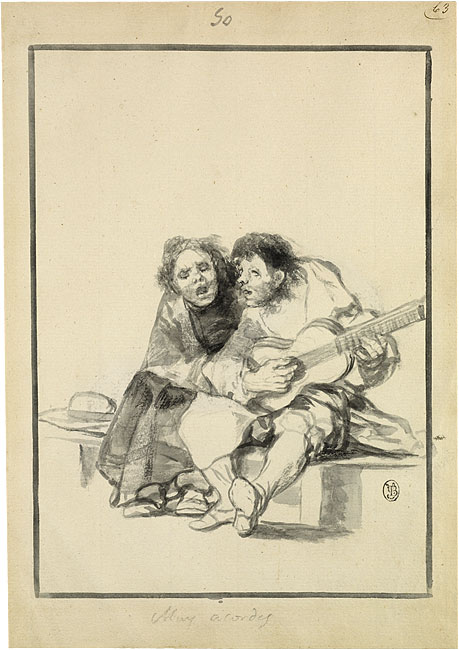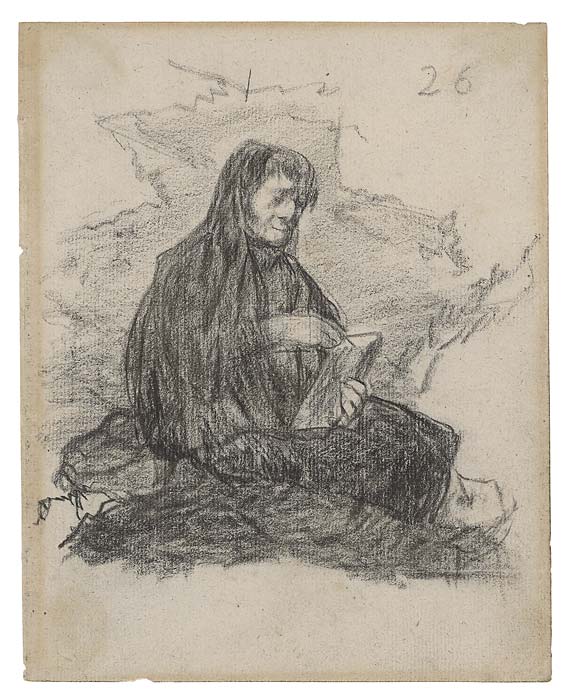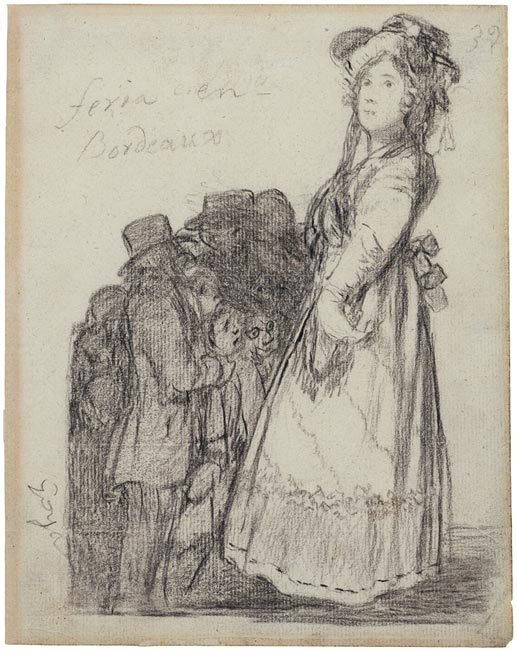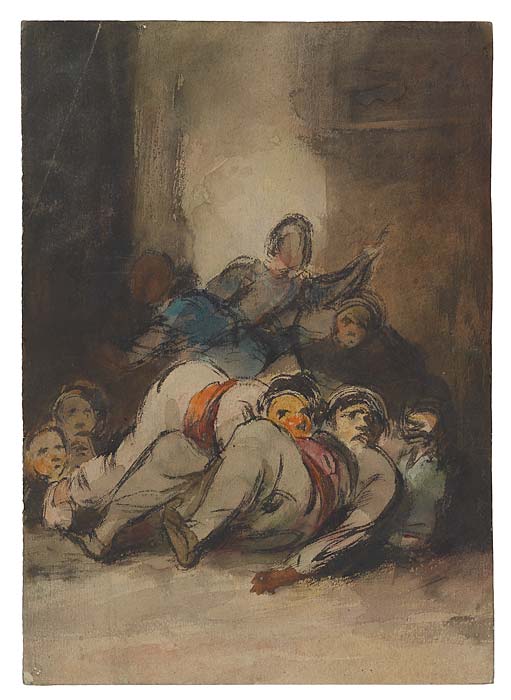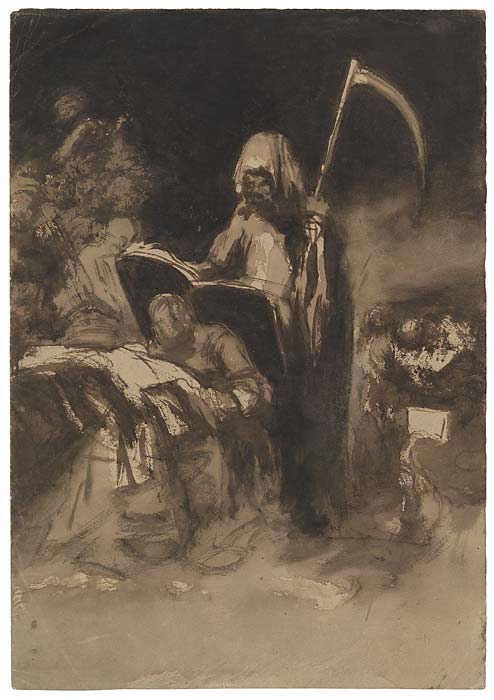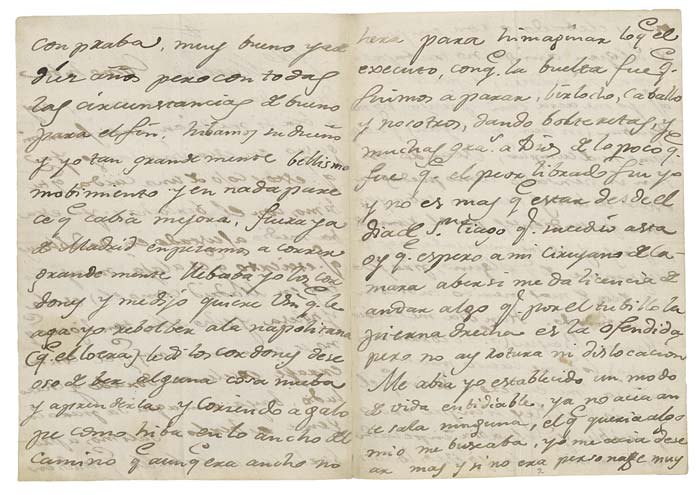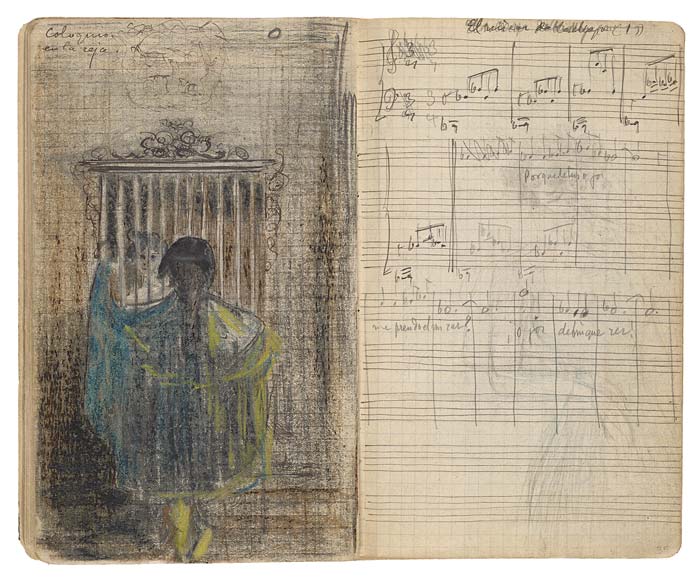Visions and Nightmares: Four Centuries of Spanish Drawings

From the sixteenth to nineteenth centuries, Spain witnessed the rise of the Catholic Church along with the flourishing of court artists who explored deeply spiritual visions. Concurrently, the nightmare of the Inquisition drove artists to probe the darker side of human nature through scenes of martyrdom and torture. Drawing played a central role in their conception of these diverse subjects—from Murillo's preparatory studies for painting commissions to Goya's private albums satirizing contemporary society. In addition to this rich tradition in Spain, Spanish artists also worked abroad, notably in Naples, which was a Spanish territory.
Visions and Nightmares marks the first exhibition of Spanish drawings at the Morgan, whose holdings in this area are small but significant. Showcasing over twenty sheets by Spanish artists spanning four centuries, this selection traces the shifting roles and attitudes toward the art of drawing in Spain.
This online exhibition was created in conjunction with the exhibition Visions and Nightmares: Four Centuries of Spanish Drawings, on view January 17 through May 11, 2014 and organized by Edward Payne, Moore Curatorial Fellow.
This exhibition is made possible by the A. Woodner Fund.
Overview
Pedro de Campaña

The Visitation
Purchased on the Edwin H. Herzog Fund and as the gift of Hubert and Mireille Goldschmidt, 2007
A FLEMING IN SPAIN
Originally from Brussels, Pieter Kempeneer is generally known by his Spanish name, Pedro de Campaña. After assisting with decorations for the coronation of Charles V in Bologna, he moved to Seville and became the city's leading painter. This drawing is one of only two surviving preparatory sheets for his main altarpiece in the Church of Santa Ana de Triana in Seville. It depicts the episode when the pregnant Virgin visits her cousin Elizabeth, who is pregnant with John the Baptist. The hen and chicks in the foreground herald the imminent births.
From the sixteenth to nineteenth centuries, Spain witnessed the rise of the Catholic Church along with the flourishing of court artists who explored deeply spiritual visions. Concurrently, the nightmare of the Inquisition drove artists to probe the darker side of human nature through scenes of martyrdom and torture. Drawing played a central role in their conception of these diverse subjects—from Murillo's preparatory studies for painting commissions to Goya's private albums satirizing contemporary society. In addition to this rich tradition in Spain, Spanish artists also worked abroad, notably in Naples, which was a Spanish territory.
Visions and Nightmares marks the first exhibition of Spanish drawings at the Morgan, whose holdings in this area are small but significant. Showcasing over twenty sheets by Spanish artists spanning four centuries, this selection traces the shifting roles and attitudes toward the art of drawing in Spain.
This online exhibition was created in conjunction with the exhibition Visions and Nightmares: Four Centuries of Spanish Drawings, on view January 17 through May 11, 2014 and organized by Edward Payne, Moore Curatorial Fellow.
This exhibition is made possible by the A. Woodner Fund.
Miguel Barroso

Design for a Cope with SS. John and Luke
Inscribed at lower right, Sct Joan y san marcos; numbered at upper right, 6.
Purchased on the Lois and Walter C. Baker Fund, 1985
GLORIFYING THE CHURCH THROUGH GARMENTS
This is one of a series of designs executed by the little known Miguel Barroso for the embroidery of liturgical vestments at the Monastery of El Escorial. Pricked for transfer and for a shoulder-length garment, the drawing depicts SS. John and Luke seated in a landscape with their respective attributes, the eagle and ox. At the lower right, a later owner of the sheet correctly identified John but mistook Luke for Mark, whose attribute is a lion. A faint outline of John's face, a copy after the finished figure, hovers at lower left.
From the sixteenth to nineteenth centuries, Spain witnessed the rise of the Catholic Church along with the flourishing of court artists who explored deeply spiritual visions. Concurrently, the nightmare of the Inquisition drove artists to probe the darker side of human nature through scenes of martyrdom and torture. Drawing played a central role in their conception of these diverse subjects—from Murillo's preparatory studies for painting commissions to Goya's private albums satirizing contemporary society. In addition to this rich tradition in Spain, Spanish artists also worked abroad, notably in Naples, which was a Spanish territory.
Visions and Nightmares marks the first exhibition of Spanish drawings at the Morgan, whose holdings in this area are small but significant. Showcasing over twenty sheets by Spanish artists spanning four centuries, this selection traces the shifting roles and attitudes toward the art of drawing in Spain.
This online exhibition was created in conjunction with the exhibition Visions and Nightmares: Four Centuries of Spanish Drawings, on view January 17 through May 11, 2014 and organized by Edward Payne, Moore Curatorial Fellow.
This exhibition is made possible by the A. Woodner Fund.
Vicente Carducho

Martyrdom of Father Andrés
Inscribed at upper center, este santo / se hara maior / y mas en medio.
Gift of Gertrude W. and Seth Dennis, 1986
A PATRON INTERVENES
Celebrated for his treatise on painting, Carducho was also an accomplished painter and draftsman. This drawing is one of many preparatory sheets for a series of fifty-six paintings that the artist designed for the Charterhouse of El Paular. In the foreground, the prior Father Andrés is tortured by a device called la garrucha; the background reveals his subsequent murder by a mob. Squared for transfer to the oil sketch that preceded the final painting, the drawing bears an inscription by the patron indicating that the suspended figure should be larger and more centered. Carducho incorporated this correction into the finished canvas.
From the sixteenth to nineteenth centuries, Spain witnessed the rise of the Catholic Church along with the flourishing of court artists who explored deeply spiritual visions. Concurrently, the nightmare of the Inquisition drove artists to probe the darker side of human nature through scenes of martyrdom and torture. Drawing played a central role in their conception of these diverse subjects—from Murillo's preparatory studies for painting commissions to Goya's private albums satirizing contemporary society. In addition to this rich tradition in Spain, Spanish artists also worked abroad, notably in Naples, which was a Spanish territory.
Visions and Nightmares marks the first exhibition of Spanish drawings at the Morgan, whose holdings in this area are small but significant. Showcasing over twenty sheets by Spanish artists spanning four centuries, this selection traces the shifting roles and attitudes toward the art of drawing in Spain.
This online exhibition was created in conjunction with the exhibition Visions and Nightmares: Four Centuries of Spanish Drawings, on view January 17 through May 11, 2014 and organized by Edward Payne, Moore Curatorial Fellow.
This exhibition is made possible by the A. Woodner Fund.
José de Ribera
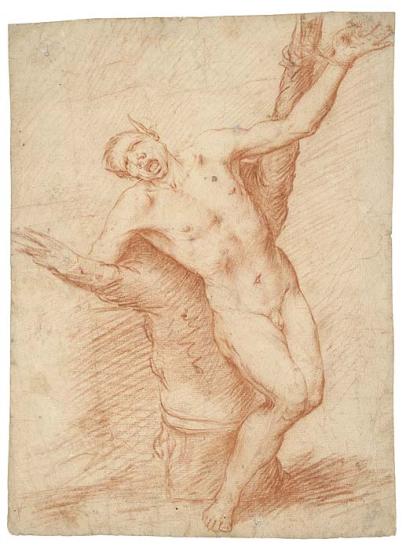
Marsyas Bound to a Tree
Purchased as the gift of Frederick R. Koch, 1976
MARSYAS TORTURED FOR PRIDE
Ribera was drawn to violent subjects—notably, the flaying of St. Bartholomew and his pagan counterpart, Marsyas, a satyr who challenged Apollo to a musical contest. As punishment for losing the competition and for his sin of pride, Marsyas was tied to a tree and skinned alive. This independent drawing depicts the bound satyr screaming, his skin still intact. Ribera relates body parts to tree parts: torso to trunk, limb to branch. In a variation on the theme, he portrays Marsyas with human, rather than goat, legs, thus connecting this mythological subject to his numerous drawings of bound figures.
From the sixteenth to nineteenth centuries, Spain witnessed the rise of the Catholic Church along with the flourishing of court artists who explored deeply spiritual visions. Concurrently, the nightmare of the Inquisition drove artists to probe the darker side of human nature through scenes of martyrdom and torture. Drawing played a central role in their conception of these diverse subjects—from Murillo's preparatory studies for painting commissions to Goya's private albums satirizing contemporary society. In addition to this rich tradition in Spain, Spanish artists also worked abroad, notably in Naples, which was a Spanish territory.
Visions and Nightmares marks the first exhibition of Spanish drawings at the Morgan, whose holdings in this area are small but significant. Showcasing over twenty sheets by Spanish artists spanning four centuries, this selection traces the shifting roles and attitudes toward the art of drawing in Spain.
This online exhibition was created in conjunction with the exhibition Visions and Nightmares: Four Centuries of Spanish Drawings, on view January 17 through May 11, 2014 and organized by Edward Payne, Moore Curatorial Fellow.
This exhibition is made possible by the A. Woodner Fund.
José de Ribera
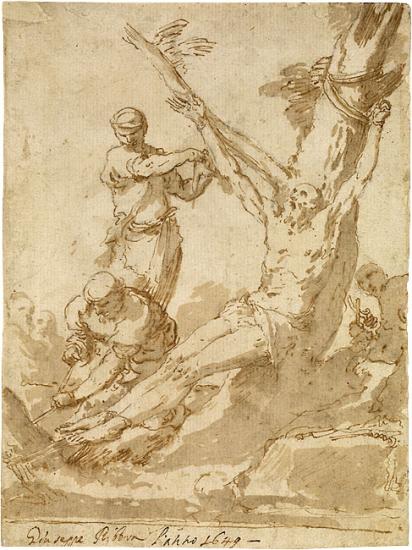
Martyrdom of St. Bartholomew
Inscribed in pen and brown ink at lower edge, Giusepe Ribera l'anno 1649
Purchased by Pierpont Morgan, 1910
BARTHOLOMEW FLAYED ALIVE
One of Ribera's favorite subjects was St. Bartholomew, an apostle and missionary who was skinned alive for his Christian faith. The artist depicted Bartholomew's martyrdom in an earlier print, whose composition may have served as a model for this drawing. The distinctive arrangement of figures—from the knife sharpener at far right, to his counterpart binding Bartholomew's legs, to the standing executioner flaying his forearm—lends the drawing an instructional dimension, demonstrating, step by step, how to martyr a saint. The inscription below is not in Ribera's hand but may have been added by a later owner of the sheet.
From the sixteenth to nineteenth centuries, Spain witnessed the rise of the Catholic Church along with the flourishing of court artists who explored deeply spiritual visions. Concurrently, the nightmare of the Inquisition drove artists to probe the darker side of human nature through scenes of martyrdom and torture. Drawing played a central role in their conception of these diverse subjects—from Murillo's preparatory studies for painting commissions to Goya's private albums satirizing contemporary society. In addition to this rich tradition in Spain, Spanish artists also worked abroad, notably in Naples, which was a Spanish territory.
Visions and Nightmares marks the first exhibition of Spanish drawings at the Morgan, whose holdings in this area are small but significant. Showcasing over twenty sheets by Spanish artists spanning four centuries, this selection traces the shifting roles and attitudes toward the art of drawing in Spain.
This online exhibition was created in conjunction with the exhibition Visions and Nightmares: Four Centuries of Spanish Drawings, on view January 17 through May 11, 2014 and organized by Edward Payne, Moore Curatorial Fellow.
This exhibition is made possible by the A. Woodner Fund.
Alonso Cano
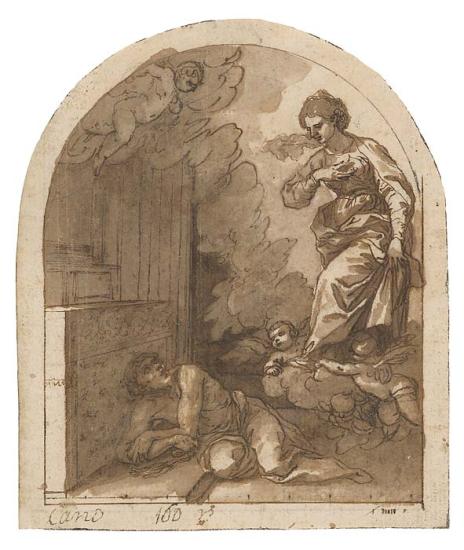
Virgin Appearing to a Man
Inscribed at lower left, Cano / 160 rs.
Purchased by Pierpont Morgan, 1909
A FLAGELLANT'S VISION
In contrast to Cano's monumental altarpiece design, exhibited nearby, this minute drawing with an arched top depicts the Lactating Virgin appearing to a flagellant who may personify the Christian soul. Before executing the figures, Cano meticulously planned the composition by including scale markings with 7-millimeter intervals at the bottom of the page. Although the iconography is difficult to interpret, the flagellant, lying before an altar, is startled by the vision engendered by his prayer and physical punishment. The viewer can contemplate two images: the flagellant who is experiencing the vision and the vision itself.
From the sixteenth to nineteenth centuries, Spain witnessed the rise of the Catholic Church along with the flourishing of court artists who explored deeply spiritual visions. Concurrently, the nightmare of the Inquisition drove artists to probe the darker side of human nature through scenes of martyrdom and torture. Drawing played a central role in their conception of these diverse subjects—from Murillo's preparatory studies for painting commissions to Goya's private albums satirizing contemporary society. In addition to this rich tradition in Spain, Spanish artists also worked abroad, notably in Naples, which was a Spanish territory.
Visions and Nightmares marks the first exhibition of Spanish drawings at the Morgan, whose holdings in this area are small but significant. Showcasing over twenty sheets by Spanish artists spanning four centuries, this selection traces the shifting roles and attitudes toward the art of drawing in Spain.
This online exhibition was created in conjunction with the exhibition Visions and Nightmares: Four Centuries of Spanish Drawings, on view January 17 through May 11, 2014 and organized by Edward Payne, Moore Curatorial Fellow.
This exhibition is made possible by the A. Woodner Fund.
Attributed to Alonso Cano

Virgin of Mercy
Inscribed at lower left, Al°o C°o.
Purchased on the Fellows Fund with the special assistance of Mrs. James J. Rorimer, 1974
AN UNUSUAL VIRGIN
This drawing depicts the Virgin of Mercy in a trompe l'oeil architectural surround, with an eagle below. While its attribution to Cano, who was appointed architect to Granada Cathedral in 1667, has been questioned, the sheet may be connected to his design for the facade of the cathedral that served as the basis for the scheme realized after his death. The Virgin of Mercy, who shelters the faithful under her cloak, is relatively uncommon in seventeenth-century Spanish art outside of Catalonia. Nevertheless, the drawing may have been intended as a modello for one of the cathedral's sculpted reliefs.
From the sixteenth to nineteenth centuries, Spain witnessed the rise of the Catholic Church along with the flourishing of court artists who explored deeply spiritual visions. Concurrently, the nightmare of the Inquisition drove artists to probe the darker side of human nature through scenes of martyrdom and torture. Drawing played a central role in their conception of these diverse subjects—from Murillo's preparatory studies for painting commissions to Goya's private albums satirizing contemporary society. In addition to this rich tradition in Spain, Spanish artists also worked abroad, notably in Naples, which was a Spanish territory.
Visions and Nightmares marks the first exhibition of Spanish drawings at the Morgan, whose holdings in this area are small but significant. Showcasing over twenty sheets by Spanish artists spanning four centuries, this selection traces the shifting roles and attitudes toward the art of drawing in Spain.
This online exhibition was created in conjunction with the exhibition Visions and Nightmares: Four Centuries of Spanish Drawings, on view January 17 through May 11, 2014 and organized by Edward Payne, Moore Curatorial Fellow.
This exhibition is made possible by the A. Woodner Fund.
Alonso Cano
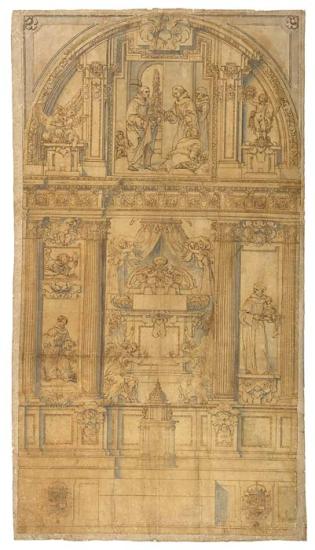
Design for the Altarpiece of the Chapel of San Diego de Alcalá, Convent of Santa María de Jesús, Alcalá de Henares
Purchased as the gift of Mrs. Charles Wrightsman, 1986
CANO'S GREATEST DRAWING
This monumental design is undoubtedly Cano's masterpiece on paper. Composed of seventeen joined sheets, it served as a plan for the altarpiece of the Chapel of San Diego de Alcalá. Philip IV became patron of the chapel in 1657, and his coats of arms appear at the lower left and right of the drawing. The highly finished execution indicates that this was a presentation drawing, offering the king different options to consider, including a proposed painting of St. Francis at lower left and a proposed sculpture of St. Anthony of Padua at lower right.
From the sixteenth to nineteenth centuries, Spain witnessed the rise of the Catholic Church along with the flourishing of court artists who explored deeply spiritual visions. Concurrently, the nightmare of the Inquisition drove artists to probe the darker side of human nature through scenes of martyrdom and torture. Drawing played a central role in their conception of these diverse subjects—from Murillo's preparatory studies for painting commissions to Goya's private albums satirizing contemporary society. In addition to this rich tradition in Spain, Spanish artists also worked abroad, notably in Naples, which was a Spanish territory.
Visions and Nightmares marks the first exhibition of Spanish drawings at the Morgan, whose holdings in this area are small but significant. Showcasing over twenty sheets by Spanish artists spanning four centuries, this selection traces the shifting roles and attitudes toward the art of drawing in Spain.
This online exhibition was created in conjunction with the exhibition Visions and Nightmares: Four Centuries of Spanish Drawings, on view January 17 through May 11, 2014 and organized by Edward Payne, Moore Curatorial Fellow.
This exhibition is made possible by the A. Woodner Fund.
Attributed to Juan Carreño de Miranda
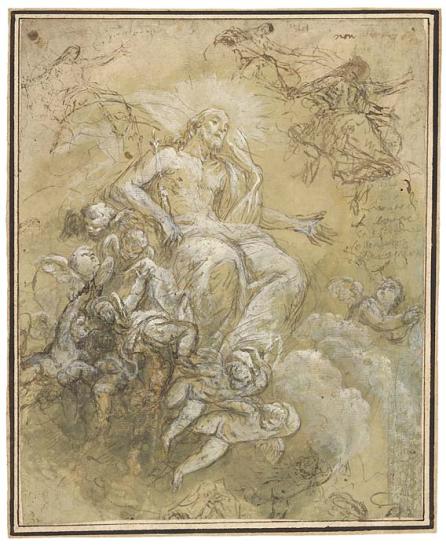
Studies of Christ in Glory
Purchased on the Seligman Charitable Trust Fund, 2013
A NEWLY DISCOVERED DESIGN FOR AN ALTARPIECE
This recently discovered sheet has been attributed to Carreño de Miranda, an artist who succeeded Velázquez as the most talented portrait painter in Madrid. The energetically described Christ borne aloft by putti recalls the composition of Carreño's altarpiece depicting the Mass of St. John of Matha, commissioned by the Trinitarian order for their new monastic church in Pamplona. Since Carreño is less known as a draftsman and few examples of his work in ink and wash survive for comparison, it leaves open the possibility that this study was executed by another Spanish, or even Italian, artist.
From the sixteenth to nineteenth centuries, Spain witnessed the rise of the Catholic Church along with the flourishing of court artists who explored deeply spiritual visions. Concurrently, the nightmare of the Inquisition drove artists to probe the darker side of human nature through scenes of martyrdom and torture. Drawing played a central role in their conception of these diverse subjects—from Murillo's preparatory studies for painting commissions to Goya's private albums satirizing contemporary society. In addition to this rich tradition in Spain, Spanish artists also worked abroad, notably in Naples, which was a Spanish territory.
Visions and Nightmares marks the first exhibition of Spanish drawings at the Morgan, whose holdings in this area are small but significant. Showcasing over twenty sheets by Spanish artists spanning four centuries, this selection traces the shifting roles and attitudes toward the art of drawing in Spain.
This online exhibition was created in conjunction with the exhibition Visions and Nightmares: Four Centuries of Spanish Drawings, on view January 17 through May 11, 2014 and organized by Edward Payne, Moore Curatorial Fellow.
This exhibition is made possible by the A. Woodner Fund.
Bartolomé Esteban Murillo
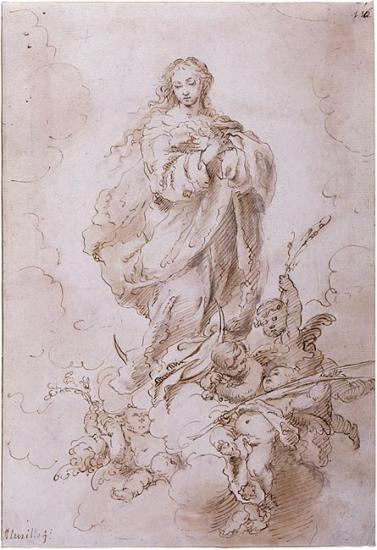
The Immaculate Conception
Signed (?) at lower left, in brown ink, Murillo ft.; numbered at upper right, 116
Gift of J. P. Morgan, Jr., 1924
Murillo made this preparatory sketch for one of his many versions of the Immaculate Conception. The free, sketchy handling of this drawing is typical of the artist’s late style and the work is close to one of his paintings, now in the Cleveland Museum of Art, as well as a small picture in a private Spanish collection. The doctrine of the Immaculate Conception was especially popular in seventeenth-century Spain. Here, this abstract ideal is embodied in the figure of the Virgin standing on a crescent moon.
From the sixteenth to nineteenth centuries, Spain witnessed the rise of the Catholic Church along with the flourishing of court artists who explored deeply spiritual visions. Concurrently, the nightmare of the Inquisition drove artists to probe the darker side of human nature through scenes of martyrdom and torture. Drawing played a central role in their conception of these diverse subjects—from Murillo's preparatory studies for painting commissions to Goya's private albums satirizing contemporary society. In addition to this rich tradition in Spain, Spanish artists also worked abroad, notably in Naples, which was a Spanish territory.
Visions and Nightmares marks the first exhibition of Spanish drawings at the Morgan, whose holdings in this area are small but significant. Showcasing over twenty sheets by Spanish artists spanning four centuries, this selection traces the shifting roles and attitudes toward the art of drawing in Spain.
This online exhibition was created in conjunction with the exhibition Visions and Nightmares: Four Centuries of Spanish Drawings, on view January 17 through May 11, 2014 and organized by Edward Payne, Moore Curatorial Fellow.
This exhibition is made possible by the A. Woodner Fund.
Bartolomé Esteban Murillo
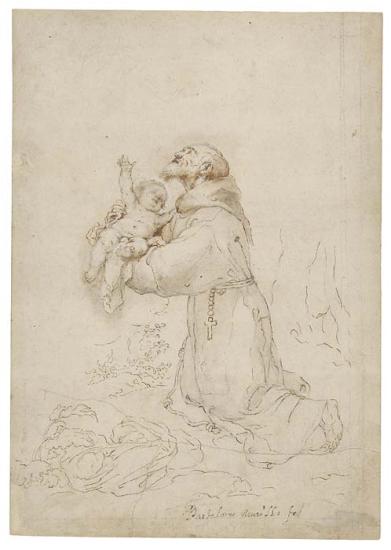
St. Felix of Cantalice Holding the Christ Child
Inscribed at lower right, Bartolome Murillo fet.
Purchased by Pierpont Morgan, 1909
ST. FELIX'S CHARITY REWARDED
Murillo was Seville's most successful artist during the seventeenth century. His largest commission was the pictorial decoration for the chapel of the Capuchinos de Sevilla. This drawing is a preparatory study for a painting of St. Felix of Cantalice, formerly on a side altar of that church. Felix was a member and patron of the Capuchins, an independent order of Franciscans; he was visited by the Virgin and Child as a reward for his charitable work. In this drawing, the artist explored the configuration of the kneeling saint and squirming Christ child, while the bread and setting are sparingly executed.
From the sixteenth to nineteenth centuries, Spain witnessed the rise of the Catholic Church along with the flourishing of court artists who explored deeply spiritual visions. Concurrently, the nightmare of the Inquisition drove artists to probe the darker side of human nature through scenes of martyrdom and torture. Drawing played a central role in their conception of these diverse subjects—from Murillo's preparatory studies for painting commissions to Goya's private albums satirizing contemporary society. In addition to this rich tradition in Spain, Spanish artists also worked abroad, notably in Naples, which was a Spanish territory.
Visions and Nightmares marks the first exhibition of Spanish drawings at the Morgan, whose holdings in this area are small but significant. Showcasing over twenty sheets by Spanish artists spanning four centuries, this selection traces the shifting roles and attitudes toward the art of drawing in Spain.
This online exhibition was created in conjunction with the exhibition Visions and Nightmares: Four Centuries of Spanish Drawings, on view January 17 through May 11, 2014 and organized by Edward Payne, Moore Curatorial Fellow.
This exhibition is made possible by the A. Woodner Fund.
Francisco de Herrera the Younger

Design for a Processional Sculpture of the Vision of St. John on Patmos, with Five Variant Plans
Inscribed at lower left, D[on] fran.co de herrera; at upper left, herrera.
Purchased as the gift of Walter C. Baker, 1960
AN APOCALYPTIC VISION
This energetic drawing represents a plan for a processional float. Surrounded by clouds and flanked by an eagle, St. John the Evangelist ascends from an ornate basin to confront his vision of the Apocalyptic Virgin: clothed by the sun, standing on the moon, and crushing a multiheaded dragon. While in Rome, Herrera would have encountered Gianlorenzo Bernini's Ecstasy of St. Teresa, whose Baroque dynamism may have inspired this design for an ephemeral sculpture. At the bottom of the sheet there are five small architectural cartouches representing aerial views of the sculpture's pedestal, with the artist's signature in the lower left cartouche.
From the sixteenth to nineteenth centuries, Spain witnessed the rise of the Catholic Church along with the flourishing of court artists who explored deeply spiritual visions. Concurrently, the nightmare of the Inquisition drove artists to probe the darker side of human nature through scenes of martyrdom and torture. Drawing played a central role in their conception of these diverse subjects—from Murillo's preparatory studies for painting commissions to Goya's private albums satirizing contemporary society. In addition to this rich tradition in Spain, Spanish artists also worked abroad, notably in Naples, which was a Spanish territory.
Visions and Nightmares marks the first exhibition of Spanish drawings at the Morgan, whose holdings in this area are small but significant. Showcasing over twenty sheets by Spanish artists spanning four centuries, this selection traces the shifting roles and attitudes toward the art of drawing in Spain.
This online exhibition was created in conjunction with the exhibition Visions and Nightmares: Four Centuries of Spanish Drawings, on view January 17 through May 11, 2014 and organized by Edward Payne, Moore Curatorial Fellow.
This exhibition is made possible by the A. Woodner Fund.
Mariano Salvador Maella
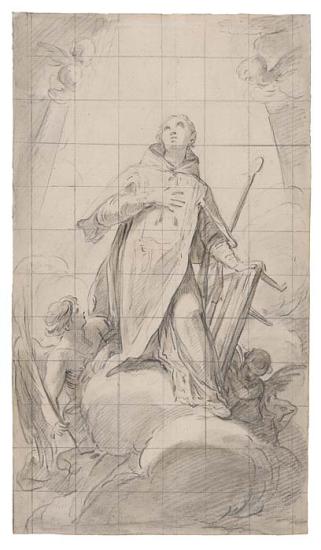
St. Lawrence
Purchase, 2013
ST. LAWRENCE TRIUMPHS OVER MARTYRDOM
Maella was one of the most successful Spanish artists employed at the court of Bourbon kings Charles III and Charles IV. This sheet depicts St. Lawrence, who was burned alive. Flanked by two angels, the saint ascends on a cloud in the center of the composition holding a grill, symbolic of his martyrdom. The drawing is squared for transfer, indicating its preparatory function for a larger painting. Maella is rarely represented in American museums, and this drawing documents his stature as one of the leading artists of eighteenth-century Spain.
From the sixteenth to nineteenth centuries, Spain witnessed the rise of the Catholic Church along with the flourishing of court artists who explored deeply spiritual visions. Concurrently, the nightmare of the Inquisition drove artists to probe the darker side of human nature through scenes of martyrdom and torture. Drawing played a central role in their conception of these diverse subjects—from Murillo's preparatory studies for painting commissions to Goya's private albums satirizing contemporary society. In addition to this rich tradition in Spain, Spanish artists also worked abroad, notably in Naples, which was a Spanish territory.
Visions and Nightmares marks the first exhibition of Spanish drawings at the Morgan, whose holdings in this area are small but significant. Showcasing over twenty sheets by Spanish artists spanning four centuries, this selection traces the shifting roles and attitudes toward the art of drawing in Spain.
This online exhibition was created in conjunction with the exhibition Visions and Nightmares: Four Centuries of Spanish Drawings, on view January 17 through May 11, 2014 and organized by Edward Payne, Moore Curatorial Fellow.
This exhibition is made possible by the A. Woodner Fund.
Francisco Goya
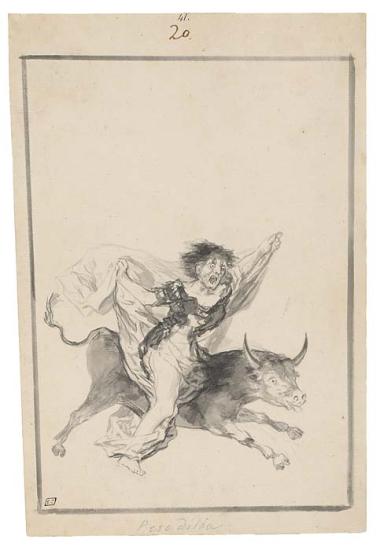
Pesadilla (Nightmare)
Black Border Album (E), page 20
Inscribed at bottom, Pesadilla; numbered at top, 20; numbered 41.
Gift of Mr. and Mrs. Richard J. Bernhard, 1959
SPAIN'S TERROR PERSONIFIED
Dreams and nightmares are a leitmotif of Goya's art. Toward the end of his life, he drew increasingly for his own pleasure, executing eight albums lettered A through H and variously named. Album E, the Black Border Album, is the largest in format and the most easily recognizable. This drawing depicts a disheveled woman astride a flying bull. Still entangled in her bedding, she screams in terror, her eyes bulging. While the image of a woman and bull traditionally personified the European continent, Goya's pair seems to personify the turmoil in Spain following the Peninsular War.
From the sixteenth to nineteenth centuries, Spain witnessed the rise of the Catholic Church along with the flourishing of court artists who explored deeply spiritual visions. Concurrently, the nightmare of the Inquisition drove artists to probe the darker side of human nature through scenes of martyrdom and torture. Drawing played a central role in their conception of these diverse subjects—from Murillo's preparatory studies for painting commissions to Goya's private albums satirizing contemporary society. In addition to this rich tradition in Spain, Spanish artists also worked abroad, notably in Naples, which was a Spanish territory.
Visions and Nightmares marks the first exhibition of Spanish drawings at the Morgan, whose holdings in this area are small but significant. Showcasing over twenty sheets by Spanish artists spanning four centuries, this selection traces the shifting roles and attitudes toward the art of drawing in Spain.
This online exhibition was created in conjunction with the exhibition Visions and Nightmares: Four Centuries of Spanish Drawings, on view January 17 through May 11, 2014 and organized by Edward Payne, Moore Curatorial Fellow.
This exhibition is made possible by the A. Woodner Fund.
Francisco Goya
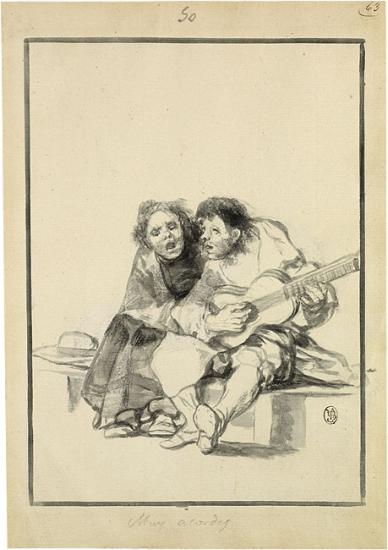
Muy accordes (Close Harmony)
Black Border Album (E), page 50
Inscribed at lower center, Muy accordes; numbered at upper center, 50; numbered at upper right, 63.
Thaw Collection
THE MUSIC OF MELANCHOLY
Music played a central role for Goya and his patrons. This sheet, the last known page from his Black Border Album, depicts a blind couple singing a cante jondo, a genre of Andalusian folk music. Following a grave illness in 1793, Goya permanently lost his hearing. The "close harmony" in the caption implies not only the musical accord of voices and guitar but also the compassion with which Goya treated the protagonists, given his own physical impairment. Moody and melancholic, this sheet foreshadows Goya's Black Paintings and the looming threat of the Inquisition.
From the sixteenth to nineteenth centuries, Spain witnessed the rise of the Catholic Church along with the flourishing of court artists who explored deeply spiritual visions. Concurrently, the nightmare of the Inquisition drove artists to probe the darker side of human nature through scenes of martyrdom and torture. Drawing played a central role in their conception of these diverse subjects—from Murillo's preparatory studies for painting commissions to Goya's private albums satirizing contemporary society. In addition to this rich tradition in Spain, Spanish artists also worked abroad, notably in Naples, which was a Spanish territory.
Visions and Nightmares marks the first exhibition of Spanish drawings at the Morgan, whose holdings in this area are small but significant. Showcasing over twenty sheets by Spanish artists spanning four centuries, this selection traces the shifting roles and attitudes toward the art of drawing in Spain.
This online exhibition was created in conjunction with the exhibition Visions and Nightmares: Four Centuries of Spanish Drawings, on view January 17 through May 11, 2014 and organized by Edward Payne, Moore Curatorial Fellow.
This exhibition is made possible by the A. Woodner Fund.
Francisco Goya

A Malefic Prophet
Bordeaux Album (H), page 26
Numbered at upper right, 26.
Gift of Gertrude Weyhe Dennis in honor of Felice Stampfle on the occasion of the 75th anniversary of the Morgan Library and the 50th anniversary of the Association of Fellows, 1999
GOYA CRITIQUES THE CLERGY
Goya's final two albums, G and H, were produced during his self-imposed exile to France. Depicting subjects that he witnessed on the streets of Paris and Bordeaux, these drawings are executed in black crayon rather than black wash, as in the previous six albums. In this notably wordless image, a figure cloaked in vaguely clerical garb sits on a rock, absorbed in his writing. His ominous presence, accentuated by the shadowy background, implies a satire on the Church. In a reversal of Christian tradition by which the word of God was communicated through writing, here the malefic figure appears to be transmitting diabolical knowledge.
From the sixteenth to nineteenth centuries, Spain witnessed the rise of the Catholic Church along with the flourishing of court artists who explored deeply spiritual visions. Concurrently, the nightmare of the Inquisition drove artists to probe the darker side of human nature through scenes of martyrdom and torture. Drawing played a central role in their conception of these diverse subjects—from Murillo's preparatory studies for painting commissions to Goya's private albums satirizing contemporary society. In addition to this rich tradition in Spain, Spanish artists also worked abroad, notably in Naples, which was a Spanish territory.
Visions and Nightmares marks the first exhibition of Spanish drawings at the Morgan, whose holdings in this area are small but significant. Showcasing over twenty sheets by Spanish artists spanning four centuries, this selection traces the shifting roles and attitudes toward the art of drawing in Spain.
This online exhibition was created in conjunction with the exhibition Visions and Nightmares: Four Centuries of Spanish Drawings, on view January 17 through May 11, 2014 and organized by Edward Payne, Moore Curatorial Fellow.
This exhibition is made possible by the A. Woodner Fund.
Francisco Goya
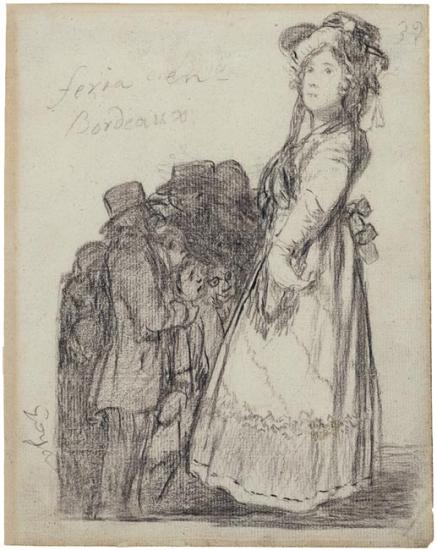
Feria en Bordeaux
Inscribed and numbered by the artist at upper center, in black crayon, feria en – / Bordeaux, at upper right, 39
Gift of Gertrude Weyhe Dennis in honor of Felice Stampfle on the occasion of the 75th anniversary of the Morgan Library and the 50th anniversary of the Association of Fellows
THE FEMALE GIANT
In 1826 Goya made several drawings depicting attractions at the fair in Bordeaux. One such spectacle was the female giant, whom he portrayed towering over a crowd of ogling sensation seekers. By compressing this group, Goya created a margin to the left where he has added his signature. The pentimento of the woman's right arm, previously raised above the crowd, accentuates the crude gaze, directed at her anatomy, of two male spectators. Goya thus offers an inverted vision of humanity by contrasting the dignity of the fairground freak with the indecorous stares from the crowd below.
From the sixteenth to nineteenth centuries, Spain witnessed the rise of the Catholic Church along with the flourishing of court artists who explored deeply spiritual visions. Concurrently, the nightmare of the Inquisition drove artists to probe the darker side of human nature through scenes of martyrdom and torture. Drawing played a central role in their conception of these diverse subjects—from Murillo's preparatory studies for painting commissions to Goya's private albums satirizing contemporary society. In addition to this rich tradition in Spain, Spanish artists also worked abroad, notably in Naples, which was a Spanish territory.
Visions and Nightmares marks the first exhibition of Spanish drawings at the Morgan, whose holdings in this area are small but significant. Showcasing over twenty sheets by Spanish artists spanning four centuries, this selection traces the shifting roles and attitudes toward the art of drawing in Spain.
This online exhibition was created in conjunction with the exhibition Visions and Nightmares: Four Centuries of Spanish Drawings, on view January 17 through May 11, 2014 and organized by Edward Payne, Moore Curatorial Fellow.
This exhibition is made possible by the A. Woodner Fund.
Eugenio Lucas
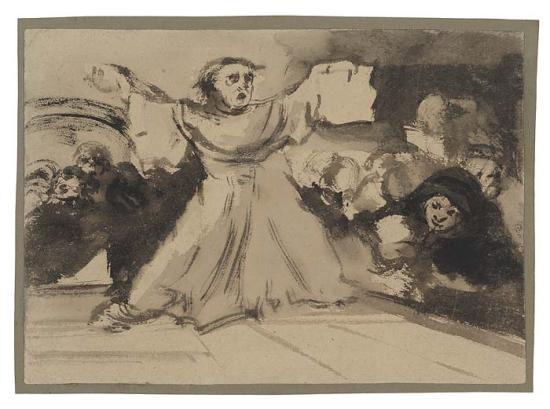
Priest Declaiming
Purchased by Pierpont Morgan, 1909
GOYA'S LEGACY
This drawing of an orating priest, gesticulating and brandishing a document, attests to Lucas's affinity with the art of Goya. The masklike faces of the protagonist and onlookers suggest a macabre scene, and the stage from which the priest proclaims adds a theatrical element to the episode. With this work, Lucas not only demonstrated his debt to his predecessor but also paved the way toward an abbreviated approach to figurative expression, foreshadowing his more abstract works.
From the sixteenth to nineteenth centuries, Spain witnessed the rise of the Catholic Church along with the flourishing of court artists who explored deeply spiritual visions. Concurrently, the nightmare of the Inquisition drove artists to probe the darker side of human nature through scenes of martyrdom and torture. Drawing played a central role in their conception of these diverse subjects—from Murillo's preparatory studies for painting commissions to Goya's private albums satirizing contemporary society. In addition to this rich tradition in Spain, Spanish artists also worked abroad, notably in Naples, which was a Spanish territory.
Visions and Nightmares marks the first exhibition of Spanish drawings at the Morgan, whose holdings in this area are small but significant. Showcasing over twenty sheets by Spanish artists spanning four centuries, this selection traces the shifting roles and attitudes toward the art of drawing in Spain.
This online exhibition was created in conjunction with the exhibition Visions and Nightmares: Four Centuries of Spanish Drawings, on view January 17 through May 11, 2014 and organized by Edward Payne, Moore Curatorial Fellow.
This exhibition is made possible by the A. Woodner Fund.
Eugenio Lucas

Crowd with Fallen Figures
Purchased by Pierpont Morgan, 1909
A ROUGH CROWD
Lucas frequently portrayed scenes of everyday life. In contrast to his drawing of a Figure Ascending Over a Crowd, exhibited nearby, this sheet depicts a group of figures who have fallen to the ground, perhaps the result of a brawl. Here the artist suppressed narrative in order to capture the drama of a moment through the calculated arrangement of abbreviated forms and interwoven bodies.
From the sixteenth to nineteenth centuries, Spain witnessed the rise of the Catholic Church along with the flourishing of court artists who explored deeply spiritual visions. Concurrently, the nightmare of the Inquisition drove artists to probe the darker side of human nature through scenes of martyrdom and torture. Drawing played a central role in their conception of these diverse subjects—from Murillo's preparatory studies for painting commissions to Goya's private albums satirizing contemporary society. In addition to this rich tradition in Spain, Spanish artists also worked abroad, notably in Naples, which was a Spanish territory.
Visions and Nightmares marks the first exhibition of Spanish drawings at the Morgan, whose holdings in this area are small but significant. Showcasing over twenty sheets by Spanish artists spanning four centuries, this selection traces the shifting roles and attitudes toward the art of drawing in Spain.
This online exhibition was created in conjunction with the exhibition Visions and Nightmares: Four Centuries of Spanish Drawings, on view January 17 through May 11, 2014 and organized by Edward Payne, Moore Curatorial Fellow.
This exhibition is made possible by the A. Woodner Fund.
Eugenio Lucas

Figure Ascending Over a Crowd
Purchased by Pierpont Morgan, 1909
A MACABRE RESURRECTION
This sheet is one of the most abstract and painterly of Lucas's drawings. The composition is difficult to read, its obscure forms implying a subject of allegory, religion, or witchcraft. The principal rising figure is shrouded in white, its arms extending toward the top of the page. The artist's vigorous technique is apparent in the visible brushstrokes and layering of wash. Identical in size to Death Reading from a Human Lectern, exhibited nearby, this drawing may be seen as its pendant, the two works representing death and resurrection, respectively.
From the sixteenth to nineteenth centuries, Spain witnessed the rise of the Catholic Church along with the flourishing of court artists who explored deeply spiritual visions. Concurrently, the nightmare of the Inquisition drove artists to probe the darker side of human nature through scenes of martyrdom and torture. Drawing played a central role in their conception of these diverse subjects—from Murillo's preparatory studies for painting commissions to Goya's private albums satirizing contemporary society. In addition to this rich tradition in Spain, Spanish artists also worked abroad, notably in Naples, which was a Spanish territory.
Visions and Nightmares marks the first exhibition of Spanish drawings at the Morgan, whose holdings in this area are small but significant. Showcasing over twenty sheets by Spanish artists spanning four centuries, this selection traces the shifting roles and attitudes toward the art of drawing in Spain.
This online exhibition was created in conjunction with the exhibition Visions and Nightmares: Four Centuries of Spanish Drawings, on view January 17 through May 11, 2014 and organized by Edward Payne, Moore Curatorial Fellow.
This exhibition is made possible by the A. Woodner Fund.
Eugenio Lucas
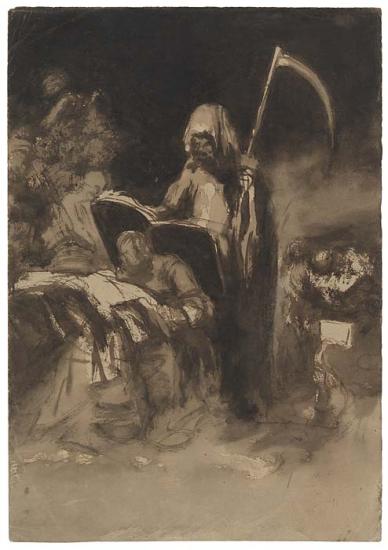
Death Reading from a Human Lectern
Purchased by Pierpont Morgan, 1909
THE GRIM REAPER PRESIDES
At the center of the composition looms a spectral, hooded figure bearing a scythe. He reads from an oversized book supported on the back of a kneeling man who serves as a human lectern. They appear to be the only figures in this macabre, tenebrous scene. Lucas created an eerie atmosphere through contrasting formal elements, leaving the spectator to wonder whom Death is addressing.
From the sixteenth to nineteenth centuries, Spain witnessed the rise of the Catholic Church along with the flourishing of court artists who explored deeply spiritual visions. Concurrently, the nightmare of the Inquisition drove artists to probe the darker side of human nature through scenes of martyrdom and torture. Drawing played a central role in their conception of these diverse subjects—from Murillo's preparatory studies for painting commissions to Goya's private albums satirizing contemporary society. In addition to this rich tradition in Spain, Spanish artists also worked abroad, notably in Naples, which was a Spanish territory.
Visions and Nightmares marks the first exhibition of Spanish drawings at the Morgan, whose holdings in this area are small but significant. Showcasing over twenty sheets by Spanish artists spanning four centuries, this selection traces the shifting roles and attitudes toward the art of drawing in Spain.
This online exhibition was created in conjunction with the exhibition Visions and Nightmares: Four Centuries of Spanish Drawings, on view January 17 through May 11, 2014 and organized by Edward Payne, Moore Curatorial Fellow.
This exhibition is made possible by the A. Woodner Fund.
El nuevo testamento
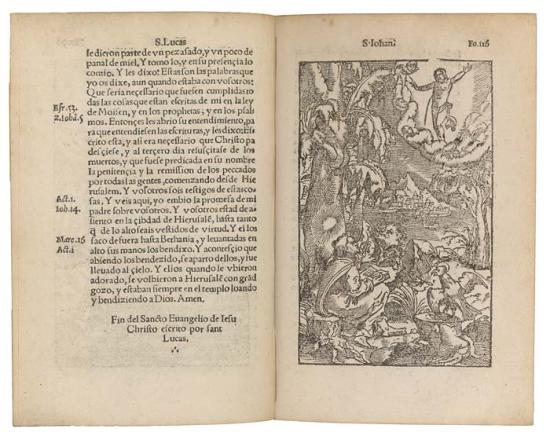
El nuevo testamento de nuestro Redemptor y Salvador Jesu Christo, traduzio de Griego en lengua Castellana
Antwerp: Stephen Mierdmann, 1543
Purchased in 1919
A STANDARD REFERENCE FOR SPANISH ARTISTS
The Church was one of the principal sources of artistic patronage in Spain. During the height of the Counter-Reformation, Spanish artists depicted primarily religious imagery: saints, gospel subjects, and scenes from the life of Christ and the Virgin Mary. This early Spanish translation of the New Testament, published in Antwerp, includes elaborate woodcut illustrations of the four Evangelists. The present opening represents St. John accompanied by his attribute, the eagle, seated in a landscape and experiencing a vision of Christ. Its distinctly Northern style recalls the internationalism of the arts in Spain.
From the sixteenth to nineteenth centuries, Spain witnessed the rise of the Catholic Church along with the flourishing of court artists who explored deeply spiritual visions. Concurrently, the nightmare of the Inquisition drove artists to probe the darker side of human nature through scenes of martyrdom and torture. Drawing played a central role in their conception of these diverse subjects—from Murillo's preparatory studies for painting commissions to Goya's private albums satirizing contemporary society. In addition to this rich tradition in Spain, Spanish artists also worked abroad, notably in Naples, which was a Spanish territory.
Visions and Nightmares marks the first exhibition of Spanish drawings at the Morgan, whose holdings in this area are small but significant. Showcasing over twenty sheets by Spanish artists spanning four centuries, this selection traces the shifting roles and attitudes toward the art of drawing in Spain.
This online exhibition was created in conjunction with the exhibition Visions and Nightmares: Four Centuries of Spanish Drawings, on view January 17 through May 11, 2014 and organized by Edward Payne, Moore Curatorial Fellow.
This exhibition is made possible by the A. Woodner Fund.
Miguel de Cervantes Saavedra Alcalá de Henares

El Ingenioso hidalgo Don Quixote de la Mancha
Madrid: Joaquin Ibarra, 1780
Purchased by Pierpont Morgan with the Toovey Collection, 1899
CELEBRATING SPAIN'S GREATEST WRITER
In 1780 the Royal Spanish Academy created a national treasure when it commissioned Joaquin Ibarra to print a deluxe edition of Don Quixote. Regarded as one of the most magnificent books of its kind, the Academy edition includes lavish engravings, careful editorial emendations to the text, a biography of Cervantes, and the first map to chart Quixote's itinerary. The most influential work of literature from the Spanish Golden Age, Don Quixote remained a cornerstone of the artistic imagination 175 years after its initial publication.
From the sixteenth to nineteenth centuries, Spain witnessed the rise of the Catholic Church along with the flourishing of court artists who explored deeply spiritual visions. Concurrently, the nightmare of the Inquisition drove artists to probe the darker side of human nature through scenes of martyrdom and torture. Drawing played a central role in their conception of these diverse subjects—from Murillo's preparatory studies for painting commissions to Goya's private albums satirizing contemporary society. In addition to this rich tradition in Spain, Spanish artists also worked abroad, notably in Naples, which was a Spanish territory.
Visions and Nightmares marks the first exhibition of Spanish drawings at the Morgan, whose holdings in this area are small but significant. Showcasing over twenty sheets by Spanish artists spanning four centuries, this selection traces the shifting roles and attitudes toward the art of drawing in Spain.
This online exhibition was created in conjunction with the exhibition Visions and Nightmares: Four Centuries of Spanish Drawings, on view January 17 through May 11, 2014 and organized by Edward Payne, Moore Curatorial Fellow.
This exhibition is made possible by the A. Woodner Fund.
Francisco Goya

Letter to Don Martín Zapater y Clavería, signed and dated 1 August 1786
The Dannie and Hettie Heineman Collection; Gift of the Heineman Foundation, 1977
GOYA CLIMBS THE RANKS
This is one of 132 surviving letters that Goya wrote between 1775 and 1801 to his lifelong friend Martín Zapater. Their correspondence contains both personal details and key facts about Goya's work. Writing in haste, Goya shares an amusing anecdote about falling from a gig and then moves on to more exciting news: in June 1786, he was appointed painter to the Spanish king Charles III, the most prestigious position for an artist in Spain. The title, as emphasized in his letter, came with a steady income and the charge to produce designs for the royal tapestry factory. "I have now established an enviable way of living," he writes, "and if anyone wants anything from me they must come to me."
From the sixteenth to nineteenth centuries, Spain witnessed the rise of the Catholic Church along with the flourishing of court artists who explored deeply spiritual visions. Concurrently, the nightmare of the Inquisition drove artists to probe the darker side of human nature through scenes of martyrdom and torture. Drawing played a central role in their conception of these diverse subjects—from Murillo's preparatory studies for painting commissions to Goya's private albums satirizing contemporary society. In addition to this rich tradition in Spain, Spanish artists also worked abroad, notably in Naples, which was a Spanish territory.
Visions and Nightmares marks the first exhibition of Spanish drawings at the Morgan, whose holdings in this area are small but significant. Showcasing over twenty sheets by Spanish artists spanning four centuries, this selection traces the shifting roles and attitudes toward the art of drawing in Spain.
This online exhibition was created in conjunction with the exhibition Visions and Nightmares: Four Centuries of Spanish Drawings, on view January 17 through May 11, 2014 and organized by Edward Payne, Moore Curatorial Fellow.
This exhibition is made possible by the A. Woodner Fund.
Enrique Granados
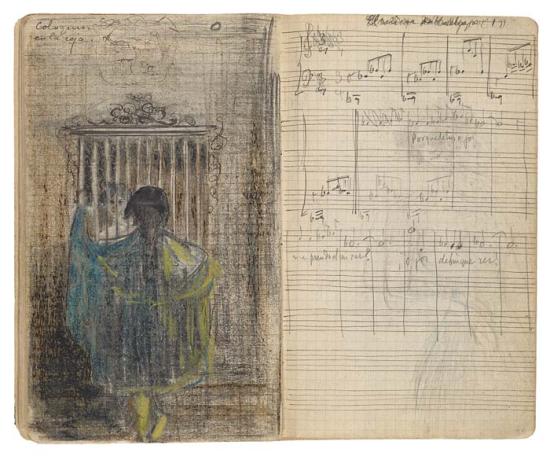
Apuntes y temas para mis obras (Notes and themes for my work)
Mary Flagler Cary Music Collection, 1985
GOYA INSPIRES GRANADOS
In this small notebook, Granados sketched ideas for his musical works: Los Ovillejos (a one-act zarzuela that was left incomplete), the Tonadillas, and his piano suite Goyescas (which borrowed ideas originally planned for Los Ovillejos). The notebook is open to a drawing, reminiscent of the works of Goya, entitled El coloquio en la reja (Dialogue at the Window), which became the title of the second number in Goyescas. On the facing page is a sketch for the tonadilla (short, satirical solo song) El mirar de la maja.
From the sixteenth to nineteenth centuries, Spain witnessed the rise of the Catholic Church along with the flourishing of court artists who explored deeply spiritual visions. Concurrently, the nightmare of the Inquisition drove artists to probe the darker side of human nature through scenes of martyrdom and torture. Drawing played a central role in their conception of these diverse subjects—from Murillo's preparatory studies for painting commissions to Goya's private albums satirizing contemporary society. In addition to this rich tradition in Spain, Spanish artists also worked abroad, notably in Naples, which was a Spanish territory.
Visions and Nightmares marks the first exhibition of Spanish drawings at the Morgan, whose holdings in this area are small but significant. Showcasing over twenty sheets by Spanish artists spanning four centuries, this selection traces the shifting roles and attitudes toward the art of drawing in Spain.
This online exhibition was created in conjunction with the exhibition Visions and Nightmares: Four Centuries of Spanish Drawings, on view January 17 through May 11, 2014 and organized by Edward Payne, Moore Curatorial Fellow.
This exhibition is made possible by the A. Woodner Fund.

